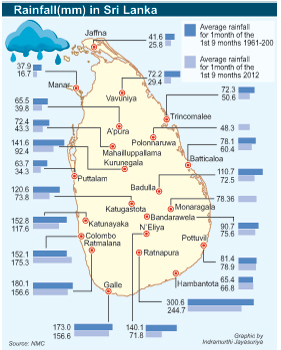News
Rain brings relief, but danger lurks in lightning strikes
October 10 was International Day of Disaster Reduction. That same week lightning strikes claimed several lives in Sri Lanka.
Although the drought appeared to be easing in some areas of the country with the onset of rains, it has come at a price with lightning strikes killing five people during the past few weeks. Two Korean tourists were among the first victims who were hit by lightning while they were enjoying the scenery from a vantage point – Lipton’s Seat. A few days later two farmers were killed in Medawachchiya.
According to Meteorology Department data, the number of deaths due to lightning has increased over the years with the number standing at 40 for this year. According to Met. Department chief meteorologist Ananda Jayasinharachchi the highest number of deaths, 50, was recorded last year. Although the data is not comprehensive as the list is compiled according to media reports, notification through personal contacts or reported by the Disaster Management Centre, many experts in the field agree that the intensity of lightning has increased over the years.

Mr. Jayasinharachchi also agreed adding that the thunder has become louder and the lightning more intense. “This could be due to climate change,” the expert meteorologist said adding that global warming resulted in extreme weather patterns. He also said population density was increasing in many areas, so a single lightning strike could cause more damage.
Sri Lanka faces two main seasons of lightning that coincide with the inter-monsoon rains. The March-April season has proved to be the worst season and experts say the lightning will be more intense in the fast approaching second season, October – November. They point out this is because during the inter-monsoon period the cloud cover is more than during the monsoon and the chances for the clouds to get electronically charged were more.
According to experts lightning incidents are more frequent in the wet zone of Sri Lanka and areas such as Horana, Avissawella and Ratnapura were more prone to them. Accordingly although the Western, Sabaragamuwa and Southern provinces are more prone to lightning, deaths have been reported consistently from other districts.
There are many form of lightning, but the ones that strike the earth are the ones that create widespread damage to property and cause injuries.
Not just humans but in the recent past, several elephants too have fallen victim to lightning.
How to determine the danger:
When a flash of lightning is observed, count the seconds before the sound of the thunder clap. Every five seconds equals one mile. Divide this by five to get the distance in miles between you and the lightning. Less than 15 seconds means you are in the danger zone, where the strike is less than three miles away.
Outdoor safety:
- Avoid being near the tallest object around
- Move to a sturdy enclosed building
- Get inside a hardtop vehicle and keep the windows rolled up
- Don’t seek shelter under isolated trees
- Do not ride bicycles or travel in an open vehicle like a tractor
- If in a boat, crouch down in the centre of the boat
- Swimming is not safe
- Wear dry slippers (wet slippers are still not safe)
Indoor safety:
- Do not use any electrical appliances and unplug unnecessary ones
- Disconnect the TV antenna, keeping socket of antenna wire closer to earth outside the house
- Do not use a corded telephone except in an emergency
- Stay away from windows and doors
First aid:
- Massage the victim
- If not breathing, give artificial respiration
Note: Touching a victim of lightning is safe. (From http://www.meteo.gov.lk)
What is lightning?
Lightning is an atmospheric discharge of electricity, which typically occurs during thunderstorms. In the atmospheric electrical discharge, a leader of a bolt of lightning can travel at speeds of 60,000 miles per second, and can reach temperatures reaching 30,000 °C (54,000 °F), hot enough to fuse silica sand. Energy of a normal lightning can be used to keep a 100 watt bulb switched on for three months.
What is thunder?
Thunder is the sound made by lightning. The sudden increase in pressure and temperature from lightning produces rapid expansion of the air surrounding and within a bolt of lightning. In turn, this expansion of air creates a sonic shock wave which produces the sound of thunder.
Inter-monsoon period begins with dry NCP receiving blessed rain
By Sonja Candappa
After the drought conditions experienced in the past few months, the second inter-monsoon period has begun with scattered thunder showers forecast in most parts of the island and especially in the parched North Central and Eastern Provinces.
Met Department Chief Meteorologist Ananda Jayasingharachchi told the Sunday Times the reason there was less rainfall this year was because there were insufficient tropical disturbances in the Bay of Bengal.
“The change in climatic activity around the Bay of Bengal is part of a global climate change and is the result of global warming,” Mr. Jayasingharachchi said. The much needed rains are expected to continue throughout October and November, depending on whether tropical disturbances are created in the Bay of Bengal.
There are two inter-monsoon periods from March to April and October to November. During this period, scattered thunder showers are experienced in the evenings, island wide. The North-East monsoon from December to mid-February affects most of the island, but especially the Northern, Eastern and North-Central Provinces.
How hail forms
Met Department Meteorologists said that hail experienced in the Haputale area was a result of the formation of cumulo-nimbus, convectional clouds over the region. Convectional clouds form when the there is insufficient rain during monsoon periods and the surface of the earth overheats, enabling water particles to evaporate and condense in the upper atmosphere and fall as hail.
Follow @timesonlinelk
comments powered by Disqus



















